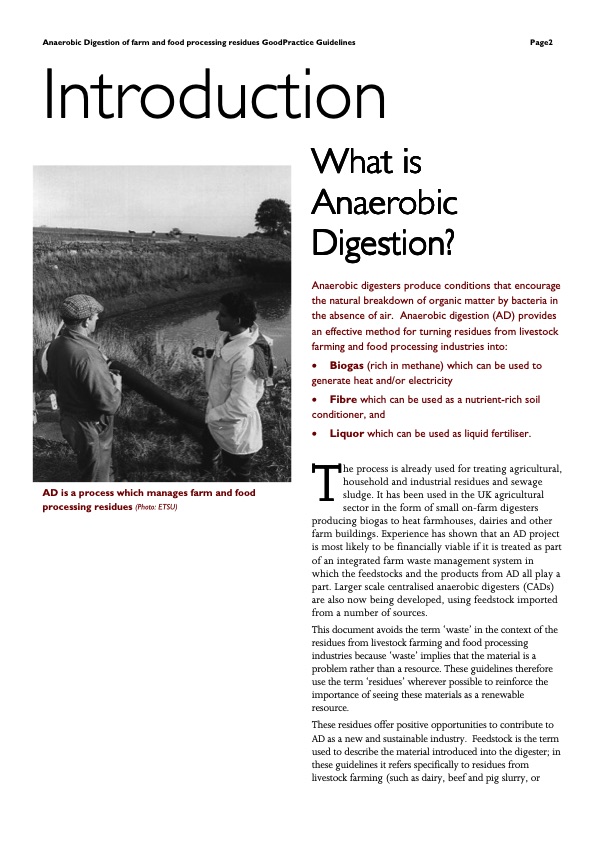
PDF Publication Title:
Text from PDF Page: 003
Anaerobic Digestion of farm and food processing residues GoodPractice Guidelines Page2 Introduction AD is a process which manages farm and food processing residues (Photo: ETSU) What is Anaerobic Digestion? Anaerobic digesters produce conditions that encourage the natural breakdown of organic matter by bacteria in the absence of air. Anaerobic digestion (AD) provides an effective method for turning residues from livestock farming and food processing industries into: • Biogas (rich in methane) which can be used to generate heat and/or electricity • Fibre which can be used as a nutrient-rich soil conditioner, and • Liquor which can be used as liquid fertiliser. The process is already used for treating agricultural, household and industrial residues and sewage sludge. It has been used in the UK agricultural sector in the form of small on-farm digesters producing biogas to heat farmhouses, dairies and other farm buildings. Experience has shown that an AD project is most likely to be financially viable if it is treated as part of an integrated farm waste management system in which the feedstocks and the products from AD all play a part. Larger scale centralised anaerobic digesters (CADs) are also now being developed, using feedstock imported from a number of sources. This document avoids the term ‘waste’ in the context of the residues from livestock farming and food processing industries because ‘waste’ implies that the material is a problem rather than a resource. These guidelines therefore use the term ‘residues’ wherever possible to reinforce the importance of seeing these materials as a renewable resource. These residues offer positive opportunities to contribute to AD as a new and sustainable industry. Feedstock is the term used to describe the material introduced into the digester; in these guidelines it refers specifically to residues from livestock farming (such as dairy, beef and pig slurry, orPDF Image | Anaerobic Digestion Of farm and food Processing residues The development of a sustainable industry

PDF Search Title:
Anaerobic Digestion Of farm and food Processing residues The development of a sustainable industryOriginal File Name Searched:
biogas10.pdfDIY PDF Search: Google It | Yahoo | Bing
Capstone Turbine and Microturbine: Capstone microturbines used and new surplus for sale listing More Info
Consulting and Strategy Services: Need help with Capstone Turbine, sizing systems, applications, or renewable energy strategy, we are here to assist More Info
Container Lumber Dry Kiln: Since 1991 developing and innovating dry kilns using standard shipping containers More Info
Supercritical CO2 Lumber Dry Kiln: Compact fast drying in 3 days or less for small amounts of wood and lumber drying More Info
BitCoin Mining: Bitcoin Mining and Cryptocurrency... More Info
Publications: Capstone Turbine publications for microturbine and distributed energy More Info
FileMaker Software for Renewable Energy Developing database software for the renewable energy industry More Info
CO2 Gas to Liquids On-Demand Production Cart Developing a supercritical CO2 to alcohol on-demand production system (via Nafion reverse fuel cell) More Info
Stranded Gas for low cost power Bitcoin Mining Using stranded gas for generators may provide breakthrough low power costs for cryptocurrency miners. More Info
| CONTACT TEL: 608-238-6001 Email: greg@globalmicroturbine.com | RSS | AMP |